Original Title: Farcaster April Notes: Open Protocol, Social Layer, and FarFi
Original Author: 0xluo.eth, Farcaster Pioneer
A lot has happened on Farcaster in the past April, and the daily active users of Farcaster have reached a new high, consistently around 40,000, making it an increasingly undeniable protocol/community in the crypto world. Of course, much of this growth may be due to the wealth effect of memecoins within the ecosystem and the launch of various new products. Despite the inevitable impact of the overall decline in the crypto market on Farcaster-related assets due to various risk factors, many friends holding Farcaster-related assets happily welcomed April and bid farewell to April. However, there are still many impressive highlights on Farcaster worth reviewing.
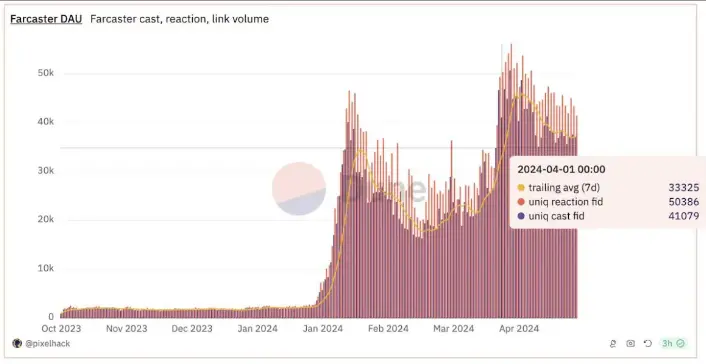
https://dune.com/pixelhack/farcaster
As I prepared to review, I found that various public chains, applications, and token ecosystems related to Farcaster are closely intertwined, with each having its own unique features. I can only attempt to break them down and discuss them from different dimensions.
Being an open protocol
First, let's start with the Farcaster protocol led by the team and the main client Warpcast. Farcaster launched the Actions feature this month, which is another important feature update after Channels and Frames. The Actions feature allows interaction with Casts below, such as liking, translating, convenient tipping, and viewing information, and can also call Frames for more interaction.

https://warpcast.com/v/0xbb2ed1b9
In addition, it is interesting that @nbragg quickly developed a hot potato game based on the Actions feature, where players can pass the potato by clicking "pass the potato" under a friend's cast. The player who receives the potato must pass it on as quickly as possible, and the player with the shortest time holding the potato wins. I look forward to seeing some social games developed based on Farcaster in the future (onchain social game or onframe-gaming) that can fully utilize the Actions feature and interact with Frames, expanding its gameplay within Farcaster and promoting viral spread in conjunction with its main game within Farcaster.
The team continues to work very hard to improve the user experience in many small details (for updates, see /fc-updates), such as setting Priority mode for Warpcast's information flow and notifications to reduce the impact of spammy accounts. It is for this reason that Farcaster has been able to maintain a relatively good community atmosphere.

https://warpcast.com/0xluo.eth/0x39918502
At the same time, third-party clients of Farcaster are also growing stronger, allowing emergency use when Warpcast is overloaded with traffic, demonstrating the openness of Farcaster as a protocol. One recent standout is @slokh's release of nook, which currently allows users to customize information flow by creating "Nooks" and "Feeds" on the mobile end, such as limiting keywords, users, and channels, making it convenient for users to track content of interest.
Furthermore, more and more clients support both Lens and Farcaster, the two major social protocols. Within the Lens ecosystem, Phaver, after actively embracing the Farcaster ecosystem following Buttrfly, has also chosen to hold activities on Farcaster and claims to support cross-platform posting for Lens and Farcaster in the future. I believe their choices indicate their awareness of the current situation. Even Vitalik's client Firefly, in addition to supporting cross-platform synchronization for Farcaster, Lens, and Twitter, further strengthens cross-platform aggregation functions, making it easier to browse articles on Mirror and Farcaster's native blog platform Paragraph, becoming a comprehensive on-chain social aggregation platform.
David Furlong's Farcaster personal homepage farcaster.in can easily link to personal homepages of Warpcast and other clients, such as Supercast, Firefly, and Yup. More Farcaster ecosystem clients can be browsed on Decaster, a one-stop navigation site developed by @haole, including clients, dApps, common tools, developer tools, common channels, Frames, Actions, and more.
Being a social layer
The main tokens and NFT assets in the Farcaster ecosystem are issued on the Base chain, which is also part of the Coinbase ecosystem. To this day, Farcaster has not only become a launchpad for memecoins but also serves as an incubator for many L3 and even L4 projects, naturally becoming the Social Layer of these memecoins in L2, L3, and L4, supporting their asset issuance, operation, promotion, and community sedimentation.
 Farcaster as social layer for L2s, L3s and L4s
Farcaster as social layer for L2s, L3s and L4s
Degen
Let's start with the leading memecoin $DEGEN, which is also on the Base chain, within the Farcaster ecosystem. Some say, "$DEGEN can no longer be considered a memecoin because it has many utilities," implying that only those without any use are memecoins. However, according to Li Jin's classification of memecoins, $DEGEN can be considered a community-first memecoin, also known as a scene memecoin:
These tokens are launched as a focal point for a decentralized community with shared values and missions, and the token can play a role in executing rituals/norms.
In this sense, many memecoins rooted in the Farcaster community can be called scene memecoins because the Farcaster community itself and its open framework make it easy for memecoins to design various types of use cases, opening up imaginative possibilities for them.
As the leading scene memecoin, $DEGEN, rooted in the Farcaster community, actively interacts with various applications and projects in the Farcaster ecosystem, and has various use cases, including sharing with $DEGEN, tipping with $DEGEN, minting with $DEGEN, trading with $DEGEN, and building with $DEGEN.
Share with $DEGEN: As a form of meme propagation, the iconic gentleman's hat, and the various Channels, Frames, NFTs, and Tokens built around this element. The "$DEGEN Memes and Symbols" section in The $DEGEN Archives provides a more detailed description.
Tip with $DEGEN: The second round airdrop of $DEGEN, where each person has a daily tipping quota that can be used to tip in the comments section of others' casts, with the total amount of tips accumulated being the airdrop quantity. Third-party clients like Supercast and Degencast support quick buttons for tipping, and there are also convenient tipping Actions available now.
Mint with $DEGEN: Both the NFT minting platforms Zora and Highlight support minting NFTs with $DEGEN. Additionally, Zora has an exclusive exploration interface for NFTs minted with $DEGEN.
Trade with $DEGEN: After the short video app Drakula, more and more Farcaster ecosystem applications such as the Bracket.game club app, the prediction platform Perl.xyz, and others support trading with $DEGEN. In the following section on FarFi, it will be seen that the majority of SocialFi products in the Farcaster ecosystem use $DEGEN as their circulating currency. The Jeeves app also lists various applications that support $DEGEN trading.
Build with $DEGEN: Utilizing Syndicate to build the Degen L3 on the Base chain, Farcaster naturally becomes the social layer supporting the Degen L3. Since its launch at the end of last month, it has quickly attracted a large number of users' attention, and memecoins such as $WAKE, $GOAT, $ATH, and the launch of FarCats Degenesis NFT have quickly gained popularity within the Farcaster community in the short term. It is worth mentioning that ATH ᖽ, born in the OG Degen Chain group chat on Warpcast, also claims to become a growth flywheel for the Degen L3 ecosystem and its community by building DAOs, games, infrastructure, and L4 based on Degen L3.
The current TPS of Degen L3 has jumped to second place in the Ethereum ecosystem, second only to the Base chain, but various infrastructures such as DeFi and NFT markets are still in the early stages. During the "Deploy on Degen" event week, 40 projects and developers received a total of over 10 million $DEGEN in bonuses. With the continuous launch of these projects, Degen L3 is expected to become more dynamic.
Base
In the past month, we have seen Jesse Pollak, the head of the Base chain, go on a frenzy of promoting various projects on the Base chain, commenting "based" everywhere. Against the backdrop of the Cancun upgrade reducing transaction costs, full support from Coinbase, and strategic cooperation with OP, the Base chain has continued its rapid growth from March, with TPS ranking first in the Ethereum ecosystem. Of course, a large part of this is the traffic brought by the explosive growth of memecoins on the Base chain, and Jesse has also raised the flag of memecoins to build the on-chain economy, even directly throwing a bag of memecoins in his PPT.
The NFT ecosystem of Base has also experienced explosive growth, to the extent that for a few days, the homepage of OpenSea was filled with Base NFTs, leading to slogans like "NFT Renaissance on Base."
Of course, what I am more concerned about is the projects closely integrated with the Farcaster community on the Base chain, including the large number of memecoins and NFT projects launched on the Base chain from Farcaster. Because of the existence of these projects, Farcaster plays a role as the social layer of the Base chain.
Scene memecoins
In addition to $DEGEN, Ham, another major memecoin in the Farcaster community developed by @deployer, is also issued on the Base chain (token name is $TN100x), with a channel/lp follower count of 30,000. Similar to tipping with $DEGEN, we can also see tipping with its iconic icon in the comments section below various casts. Similar to the path of $DEGEN, it also announced the launch of Ham L3 in April, once again gaining high attention. In addition, Ham has also launched a convenient on-chain tipping tool called Floaties, supporting various tokens including $TN100x, $DEGEN, $HIGHER, and $MEMBER for tipping in the comments section on Farcaster and Twitter, helping more memecoins expand their use cases.
Since last month, after mfer s chose to issue the memecoin mfer coin ($mfer) on the Base chain, many NFT projects have also launched their memecoins. For example, Nouns DAO community member @dotnouns raised funds in April through Party.app to launch the memecoin Noggles ($NOGS), which is based on the Nouns IP and aims to empower the entire Nouns ecosystem. They also introduced a tipping scheme on Farcaster.
$Higher is another Base chain memecoin that has attracted attention in the Farcaster ecosystem. Its iconic symbol ↑ and artworks created with it are visible everywhere in Farcaster, attracting various influencers to the /higher channel. Both Zora and Highlight have supported minting NFTs with $HIGHER.
I think part of its popularity is due to its easily understandable and communicable name and symbol. James Beck believes that Higher provides a template for easy trend creation, an art collection on Zora, and a token with investment appeal, allowing everyone to participate, thus successfully attracting all four consumer groups in the Aspirational Economy: connoisseurs, super fans, discerning buyers, and browsers.

The Aspirational Economy of $HIGHER (https://jamesbeck.mirror.xyz/5QkrHusMclOWsa9sKH4MQhG8UXMJZvi7iKXFy64YYTY)
NFTs
The Onchain gaias NFT on the Base chain has been very popular in the Farcaster community since its launch. @ciniz released Zora NFT in April to detail its vision as "Onchain General Artificial Intelligence Agents," aiming to create a revolutionary platform that allows ordinary people to access general artificial intelligence (AGI) development. The ideal sounds ambitious, and we can only wait and see.
Artist @jvmi created interactive generative art swatches, and I found it fascinating to interact with different colored shapes on their NFT interface.

The Onchain coin project, known for "rolling," released Prescription Pass and Onchain Pills NFT in April. The minting of the former even caused Basescan, Warpcast, and Highlight to crash simultaneously. They also launched the Chain Game, and announced the launch of Onchain L3 using the conduit service, aiming to attract more users to participate in on-chain activities through a game and social scoring mechanism.
The common feature of these Farcaster-rooted projects is that by managing the community on Farcaster, accumulating reputation, they can quickly gain community support from preheating to launch, which will also become a lasting driving force for their continued development.
Onchain games
In terms of blockchain games, the MMORPG game EthXY on the Base chain also announced that they will use the chaindrop service to build an L3 based on the Base chain. Previously, the "Luckshot Duel" and "Loot Drop" Frames launched on Farcaster also attracted widespread attention in the Farcaster community. It is a good example of using Frames as a window to promote and interact with their game in the Farcaster community. Another popular game on Farcaster, which has been pre-selling seed NFTs but has not yet launched, also has its own game-specific L3, goldchain, for the farming game CropXYZ, and claims to support gameplay on both the web and Frame.
I have always hoped to see blockchain games combined with the Farcaster social graph to build on-chain social games. In the Web2 era, whether it was Facebook, Renren, or QQ Space, these SNS platforms have achieved rapid growth through social + gaming, and this chemical reaction may still be valid on the blockchain. Farcaster has established a high-quality social graph and an active community, and using Farcaster's social identity can help blockchain games quickly acquire customers, promote virally, and build community stickiness. The only thing missing is playable blockchain games. I look forward to seeing more and more on-chain social games in the Farcaster ecosystem, combined with features such as Frames and Actions to interact more effectively with the community and facilitate social interaction between different users, making social games more sticky for users.
Zora
Zora has always been closely connected with Farcaster. Many NFTs on Farcaster choose to be issued in Zora on the Base chain or Zora chain. Zora supports prepaying gas through the Boost feature, allowing users to mint NFTs on Farcaster Frames without gas. Therefore, Farcaster naturally serves as the social layer for Zora dApp and the Zora chain.
In terms of the focus on the Zora chain, in April, the active addresses and transactions on the Zora chain reached historic highs. This should be related to two reasons. First, Zora announced support for minting NFTs with ERC20 tokens on different chains, providing an application scenario for many memecoins, such as $DEGEN, $HIGHER, and $CRASH on the Base chain, and the two leading memecoins $ENJOY and $IMAGINE on the Zora chain. The second reason is that $ENJOY and $IMAGINE both announced their creator incentive plans, greatly increasing users' willingness to use Zora, and minting with a comment has become a habit for many Zora users. The two reasons complement each other, driving the rapid growth of the Zora chain and the two leading scene memecoins.

https://twitter.com/AlanaDLevin/status/1778151713263747269/photo/2
$ENJOY is the largest memecoin on the Zora chain. Although it has a background in seedclub, it initially received a lukewarm response upon launch. It wasn't until early April that $ENGJOY introduced its second round airdrop plan, which can be tipped on the Zora chain. Therefore, $ENJOY as a scene memecoin has many use cases:
Share with $ENJOY: There is also a large amount of meme image creation around the $ENJOY logo blue ball and !!!.
Mint with $ENJOY: Zora supports minting with $ENJOY, and there is also an exclusive exploration interface for NFTs that can be minted with $ENJOY on Zora.
Tip with $ENJOY: The tipping for $ENJOY is in the comments section when minting NFTs, similar to $DEGEN tipping in casts comments. Similarly, because the tipping is on a weekly basis and not on-chain tokens, users are willing to tip others. In addition, the multimedia NFT client Surreal and the on-chain activity aggregation client Interface both support more convenient tipping in the comments section when minting Zora NFTs in the app, making these two clients go from niche to well-known, creating a win-win situation for Farcaster ecosystem projects.
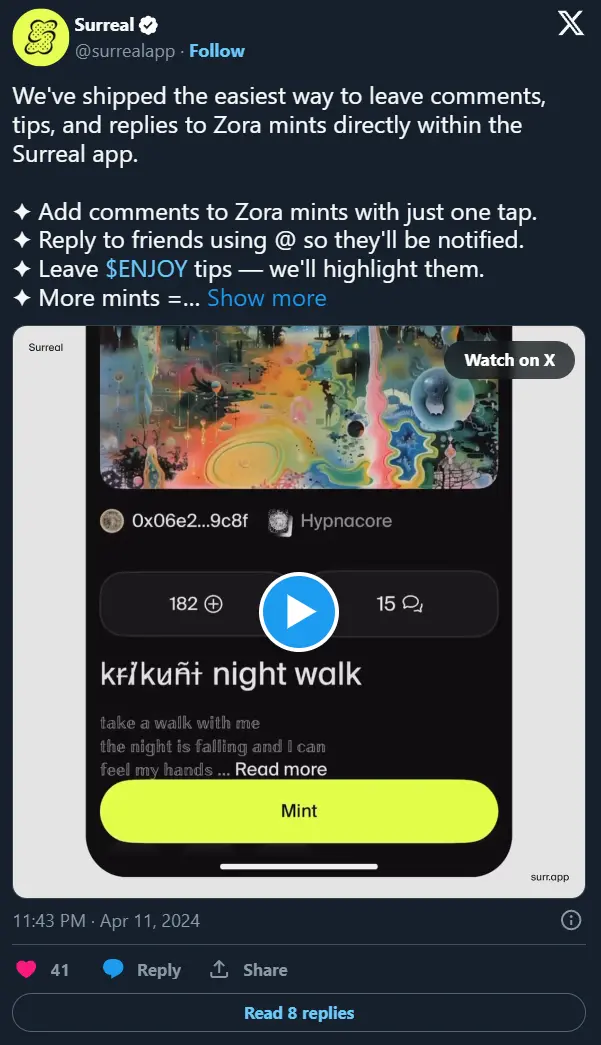
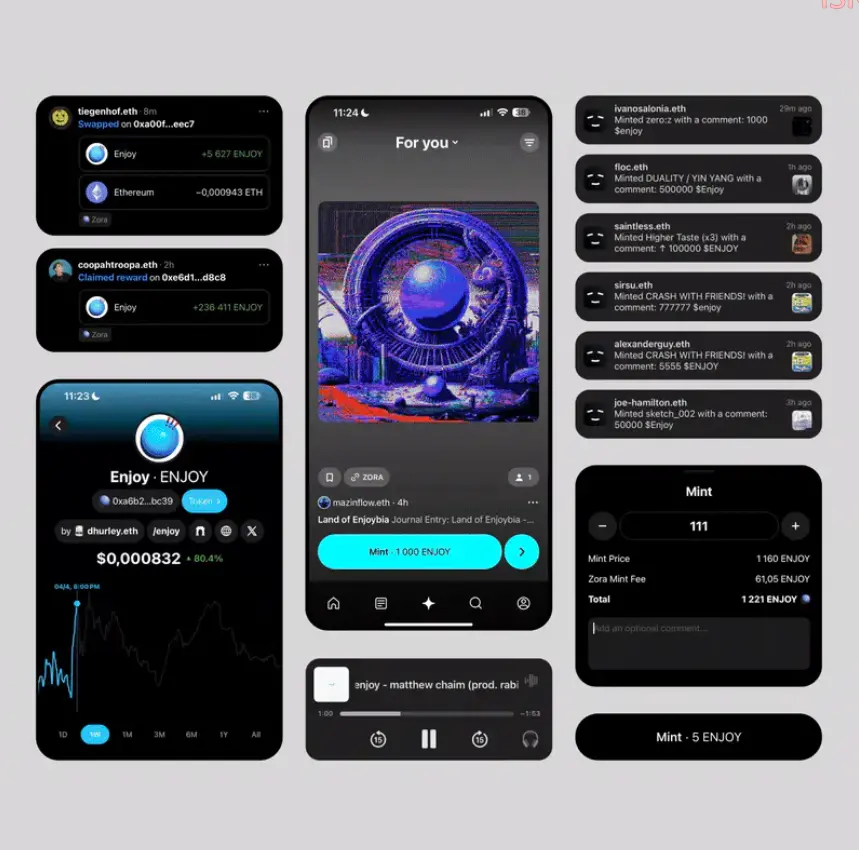
https://warpcast.com/interface/0x4eb465a7
Similar to $ENJOY, $IMAGINE has also launched its own tipping plan, and tipping can also be done in the comments section when minting Zora NFTs. Today, $ENJOY and $IMAGINE have become important parts of the creator economy on the Zora chain, and more and more artists are choosing to release their work on Zora to earn income.
In summary, Farcaster has become the stronghold of both the Base and Zora L2 chains and has become an incubator for many different types of L3 and even L4. In theory, Farcaster can become the social layer for any chain, as any project on any chain can choose to open channels on Farcaster and build a community. The openness of Frames also supports interaction with any chain for asset issuance, although there may be some differences in specific forms. Previously, projects from the BTC community and NFT projects on SOL chose to launch on Farcaster. However, due to factors such as the founders, funding background, and user habits, Farcaster has become closer to the Base and Zora chains. Will more chains embrace Farcaster in the future?
Being an enabler of FarFi
In the past period, we have seen a growing number of SocialFi/CreatorFi applications built around Farcaster, such as:
- Drakula: on-chain TikTok
- Clubcast: on-chain Patreon
- AlfaFrens: on-chain OnlyFans?
- Jam: on-chain Instagram …
I have been looking for a suitable term to describe them, so let's call them FarFi (Farcaster-based SocialFi ➔ Farcaster Finance). FarFi is an application with its token economics built on Farcaster social identity, most of which claim to empower content creators or create a co-creation economy for creators and users.
FarFi has two important components, one is Farcaster, and the other is Finance. Both of these have important differences from other SocialFi applications in the Farcaster ecosystem. The short video application Drakula built on Farcaster has quickly gained popularity, demonstrating the key role of FarFi: Farcaster's open framework and composability provide valuable on-chain social graphs for rapid customer acquisition, while scene memecoins like $DEGEN can play a role as the native circulating currency in the Farcaster ecosystem to provide asset liquidity for application cold starts. I once said Farcater + composable app Lego + $DEGEN economics = on-chain social summer, and in April, we saw a surge of FarFi apps.
Regarding FarFi, I tried to classify them based on the objects they trade, which are generally tradable profiles, casts, and channels. Moreover, the vast majority of them use the most widely used scene memecoin $DEGEN as their native circulating currency within the application.

Farcaster as an enabler for FarFi
Tradable profiles
Since the release of friend.tech last year, the pattern of trading user profiles based on bonding curve keys has become very common, and the transactions often have high fees, usually collected by the platform and shared with the creators. This pattern has become the preferred choice for building SocialFi applications based on Farcaster, except here, the profiles use Farcaster's social graph.
uncuts and farcards
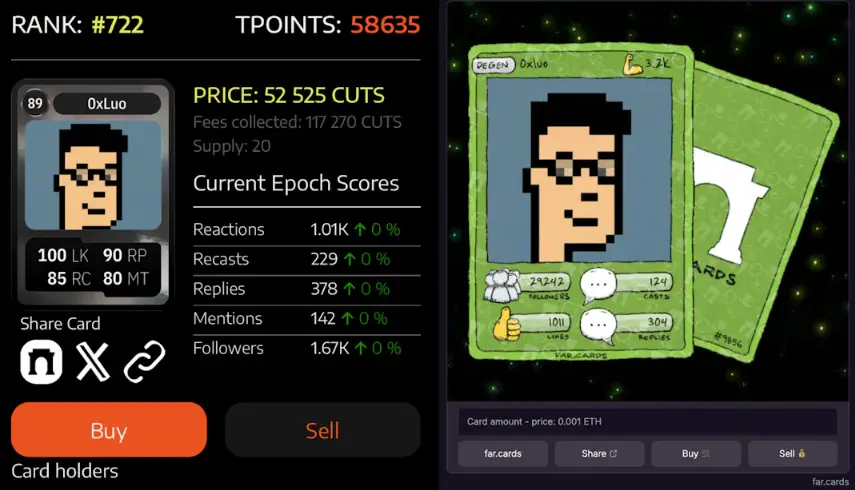
uncuts.app and Farcards
Uncuts.app, launched by REKT, is a collectible card game where users can collect and trade cards of different users and build teams, with the strength of different cards determined by their activity data on Farcaster. Farcards is somewhat similar, developed by @undefined based on mint.club, and is a collectible card game for exclusive Farcaster users. Everyone can easily forge their own card and trade other people's cards through their Frame, and the cards also have different levels based on the user's activity on Farcaster, although more gameplay has not been released yet.
If it's just about speculating on identity cards, it seems a bit lacking in imagination, and everyone is already tired of this kind of speculation. It would be interesting if a card game similar to Hearthstone and Magic: The Gathering could be designed based on different user cards.
Clubcast
The biggest feature of ClubCast is the introduction of token-gated casts. If you purchase a club token from a user, you can unlock and view their encrypted content on clubcast.xyz and Farcaster's Frame.
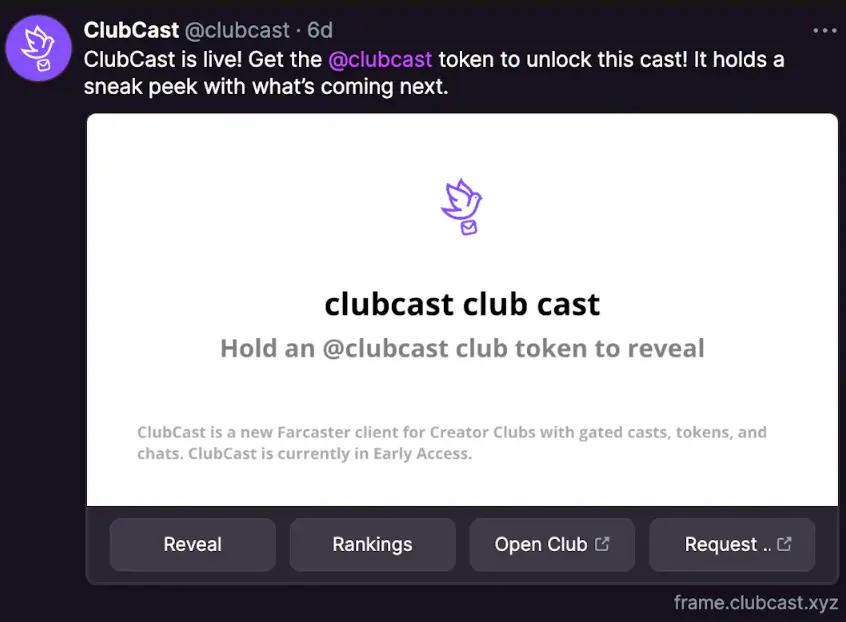
https://warpcast.com/clubcast/0xf5b90b02
Therefore, it is somewhat similar to membership websites like Patreon, where certain content can only be viewed by subscribed members. In terms of on-chain social platforms, this token-gated posts format is also present in the Lens ecosystem client Orb, where posts can be set to only be visible to those holding a specific NFT. I believe this model should be considered as infrastructure and needs applications to support the sending of content exclusively for subscribed members to view.
AlfaFrens
AlfaFrens, led by @Vijay, is a SocialFi product similar to friend.tech, providing exclusive content to subscribers. Users spend $DEGEN to subscribe to channels created by different creators (different from Farcaster's channels) and gain exclusive information from the creators within the channels, while also earning $ALFA. $ALFA can be used to stake investments in channels and earn $DEGEN rewards. The more a subscriber stakes for a creator, the more $ALFA they receive.

https://warpcast.com/0xluo.eth/0x3a357774
The significant difference from friend.tech is that AlfaFrens no longer uses the bonding curve-based Key model, but applies a dual token mining model to SocialFi. The subscription fee for channels is based on SuperFluid and billed on a time-stream basis, and subscribers can exit at any time.
The biggest impact of AlfaFrens may be in raising a question: most SocialFi products currently use various bonding curve models, but is the bonding curve the best economic model for SocialFi? The increase in the price of keys on friend.tech comes from new players joining, rather than value creation, making it difficult to sustain in the long term. AlfaFrens introduces real subscription users, effectively introducing external income, making it a rare non-Ponzi model, which may be more sustainable. Of course, this requires creators to create truly valuable content and cultivate genuine relationships with subscribers to achieve a positive cycle.
In addition, the subscription model is more effective in preventing speculators from hoarding and profiteering from the lack of supply of keys. The subscription model also does not have the price fluctuations associated with "keys," and also avoids the moral concerns about the reputation of creators, as Joan Westenberg stated:
"Binding personal branding to a volatile and short-lived token or key will have lasting negative consequences. If this key ultimately fails to meet expectations or its value significantly declines (which is inevitable), the creator's reputation will suffer permanent damage."
Tradable casts
The above often treats "people" as tradable commodities, and also focuses on trading the content itself. For example, Tiser supports the buying and selling of a specific cast through actions to access Frames, effectively enabling the trading of casts within Farcaster.
Jam is a Farcaster creator economy client, with the ability to post and browse within the app, but posts must include images, hence being called an on-chain Instagram. Additionally, it currently supports the trading of casts and profile keys, with trading volume exceeding $10 million within the first 72 hours of launch. It is worth noting that although the trading of casts uses a bonding curve pricing model, only one holder can exist at a time, effectively auctioning off the casts in rotation, to some extent reducing arbitrage opportunities for speculators and making the purchase of casts more akin to sponsoring creators.
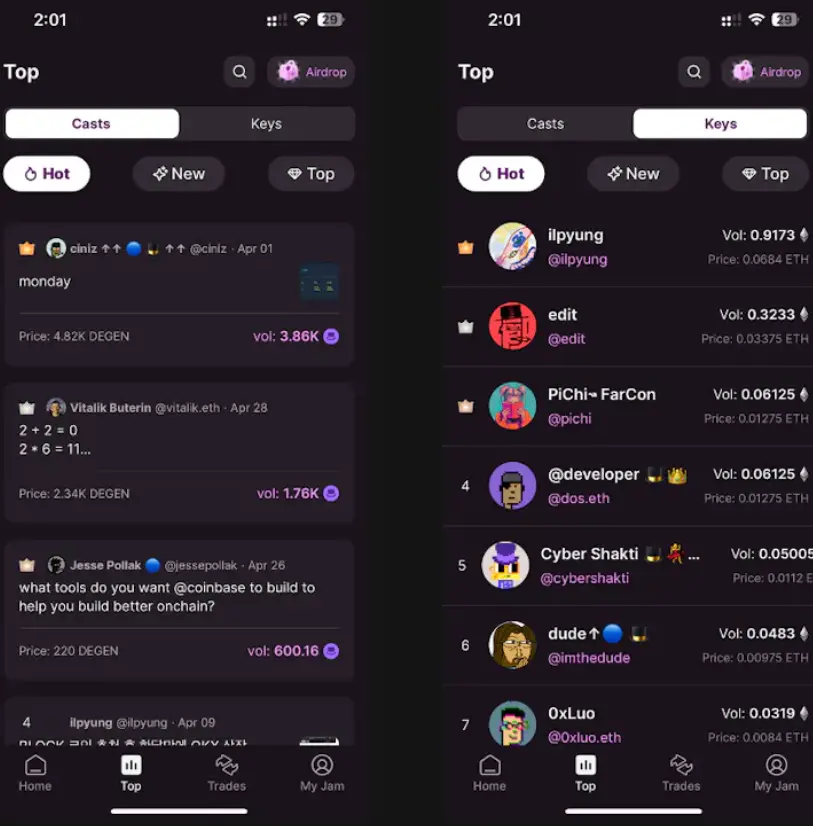
Top casts and keys page on Jam.so
Tradable channels
Within Warpcast, there is now a feature called Channel Pass that empowers channel owners. Channel owners can set a certain number of Warps as the posting access threshold using Channel Pass, reducing the publication of spam within the channel. However, this is not on-chain finance, so subscribers to the channel lack an exit mechanism.
One known project hoping to introduce SocialFi elements to channels is Degencast, developed by Liang and set to be launched soon, claiming to "tokenize" channels with $DEGEN. We will have to wait and see how it specifically empowers channels.
Of course, the potential of FarFi goes far beyond this. Leveraging the open and composable Farcaster protocol, there may be more scenarios that can be empowered by token economics, with media for dissemination being text, audio, or video, and FarFi products in different vertical fields may emerge. For example, the voice chat tool FarHouse claims it will also adopt a token-gated spaces model in the future.
Overall, the open and composable nature of the Farcaster protocol allows these FarFi products to be quickly built, and the gradual growth of $DEGEN as the liquidity layer of the Farcaster ecosystem gives confidence to launch such products. However, there are also concerns. Many FarFi products may distract the community's attention and disperse liquidity. If products also require additional content creation, it will also distract the energy of content creators. If products do not come with their own content, they may easily become purely speculative and difficult to sustain.
The most important point is that knowledge payment products must truly contain knowledge, and the creator economy needs genuine creators and good content. Only in this way will there be genuine consumers willing to pay, forming a long-term and stable creator economy model.
Conclusion
This lengthy and somewhat rambling review roughly outlines some of the most memorable content I encountered on Farcaster in April, and I hope it provides some reference for friends who want to understand the Farcaster ecosystem.
Farcaster will continue to serve as an open and composable social protocol, giving rise to various on-chain applications and supporting the ecosystems of different public chains as a social layer. May's Farcaster is still worth looking forward to, as the Farcaster summit Farcon is about to be held, and I believe the gathering of ecosystem builders will spark more ideas. Even though the crypto market is on the brink of a storm, the developer ecosystem and community culture here at Farcaster make me willing to continue being an optimist.
免责声明:本文章仅代表作者个人观点,不代表本平台的立场和观点。本文章仅供信息分享,不构成对任何人的任何投资建议。用户与作者之间的任何争议,与本平台无关。如网页中刊载的文章或图片涉及侵权,请提供相关的权利证明和身份证明发送邮件到support@aicoin.com,本平台相关工作人员将会进行核查。




